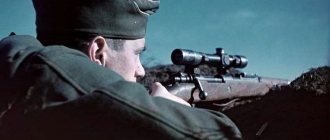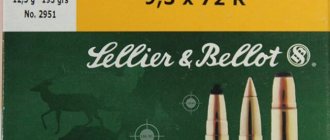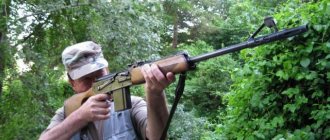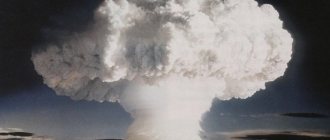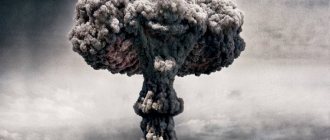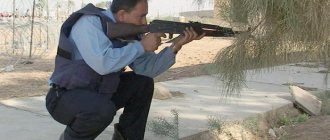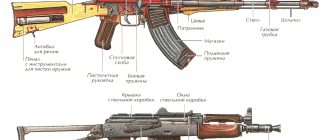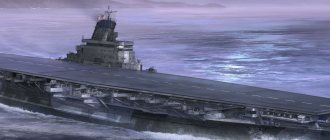If you start to imagine what the war of the future will be like, then most likely it will be combat operations without the use of armor-piercing equipment and machine guns. Opponents will begin to fire to kill each other, using electromagnetic guns with such projectiles that can fly halfway across the globe in a matter of minutes. And as the sad history of the world shows, some of these weapons have already been made by previous generations of humanity, so our descendants have something to fear for in the future. And at the same time, the most dangerous weapon on a global scale most likely has not even been invented yet. Well, we suggest you consider what we have in the selection below.
Tsar bomb
AN602 (aka “Tsar Bomb”) is a thermonuclear aerial bomb developed in the USSR in 1954-1961. a group of nuclear physicists under the leadership of Academician of the USSR Academy of Sciences I.V. Kurchatov. The Tsar Bomba is the most powerful explosive device in the history of mankind. Its use is clearly demonstrated that the Soviet Sozyu possesses weapons of mass destruction of unlimited power. The scientific result was an experimental verification of the principles of calculation and design of multi-stage thermonuclear charges.
In this publication I want to talk about the main types of weapons of mass destruction (WMD). Biological (bacteriological) weapons are pathogenic microorganisms or their spores, viruses, bacterial toxins, infected people and animals, as well as their delivery vehicles (missiles, guided missiles, automatic balloons, aircraft), intended for the mass destruction of enemy personnel and farm animals. , crops, as well as damage to certain types of military materials and equipment. It is a weapon of mass destruction and is prohibited under the Geneva Protocol of 1925.
The damaging effect of biological weapons is based primarily on the use of the pathogenic properties of pathogenic microorganisms and the toxic products of their vital activity.
Biological weapons are used in the form of various ammunition; they are equipped with certain types of bacteria that cause infectious diseases that take the form of epidemics. It is intended to infect people, crops and animals, as well as contaminate food and water sources.
Chemical weapons are weapons of mass destruction, the action of which is based on the toxic properties of toxic substances (CAS), and the means of their use: artillery shells, rockets, mines, aircraft bombs, gas launchers, balloon gas release systems, VAPs (aircraft spray devices), grenades, checkers . Along with nuclear and biological (bacteriological) weapons, it refers to weapons of mass destruction (WMD).
The use of chemical weapons has been prohibited several times by various international agreements:
The Hague Convention of 1899, article 23 of which prohibits the use of ammunition whose sole purpose is to poison enemy personnel; Geneva Protocol of 1925; The Convention on the Prohibition of the Development, Production, Stockpiling and Use of Chemical Weapons and on Their Destruction of 1993. Chemical weapons are distinguished by the following characteristics:
the nature of the physiological effects of chemical agents on the human body; tactical purpose; speed of onset of impact; durability of the agent used; means and methods of application.
Based on the nature of their physiological effects on the human body, there are six main types of toxic substances:
Nerve agents that affect the central nervous system. The purpose of using nerve agents is to quickly and massively incapacitate personnel with as many deaths as possible. Toxic substances in this group include sarin, soman, tabun and V-gases. Agents of blister action, causing damage mainly through the skin, and when used in the form of aerosols and vapors, also through the respiratory system. The main toxic substances are mustard gas and lewisite. Generally toxic agents that, when entering the body, disrupt the transfer of oxygen from the blood to the tissues. These are one of the fastest acting agents. These include hydrocyanic acid and cyanogen chloride. Agents have a suffocating effect, affecting mainly the lungs. The main agents are phosgene and diphosgene. Psychochemical agents capable of incapacitating enemy manpower for some time. These toxic substances, affecting the central nervous system, disrupt the normal mental activity of a person or cause disorders such as temporary blindness, deafness, a sense of fear, and limited motor functions. Poisoning with these substances in doses that cause mental disorders does not lead to death. OMs from this group are quinuclidyl-3-benzilate (BZ) and lysergic acid diethylamide. Irritant agents, or irritants (from the English irritant - irritating substance). Irritating substances are fast-acting. At the same time, their effect is usually short-lived, since after leaving the contaminated area, signs of poisoning disappear within 1-10 minutes. A lethal effect for irritants is possible only when doses entering the body are tens to hundreds of times higher than the minimum and optimally effective doses. Irritating agents include lachrymatory substances, which cause excessive lacrimation, and sneezing agents, which irritate the respiratory tract (can also affect the nervous system and cause skin lesions). Lachrymators (lacrimators) - CS, CN (chloroacetophenone) and PS (chloropicrin). Sneeze agents (sternites) - DM (adamsite), DA (diphenylchloroarsine) and DC (diphenylcyanarsine). There are agents that combine tear and sneeze effects. Irritating agents are in service with the police in many countries and are therefore classified as police or special non-lethal means (special means).
However, non-lethal substances can also cause death. In particular, during the Vietnam War, the American army used the following types of gases:
CS—orthochlorobenzylidene malononitrile and its formulations; CN—chloroacetophenone; DM—adamsite or chlorodihydrofenarsazine; CNS, prescription form of chloropicrin; BA (BAE) - bromoacetone; BZ—quinuclidyl-3-benzilate.
Nuclear weapons - a set of nuclear weapons, means of delivering them to the target and control means; refers to weapons of mass destruction along with biological and chemical weapons. Nuclear ammunition is an explosive weapon based on the use of nuclear energy released during a nuclear chain reaction of fission of heavy nuclei and/or thermonuclear fusion reaction of light nuclei.
When a nuclear weapon is detonated, a nuclear explosion occurs, the damaging factors of which are:
shock wave light radiation penetrating radiation radioactive contamination electromagnetic pulse (EMP) x-ray radiation
Two main categories:
“Atomic” - single-phase or single-stage explosive devices in which the main energy output comes from the nuclear reaction of fission of heavy nuclei (uranium-235 or plutonium) with the formation of lighter elements.
Thermonuclear weapons (also “hydrogen”) are two-phase or two-stage explosive devices in which two physical processes, localized in different areas of space, are sequentially developed: in the first stage, the main source of energy is the fission reaction of heavy nuclei, and in the second, fission and thermonuclear fusion reactions are used in varying proportions, depending on the type and configuration of the ammunition.
It is customary to divide nuclear weapons into five groups according to their power:
ultra-small (less than 1 ct); small (1 - 10 kt); medium (10 - 100 kt); large (high power) (100 kt - 1 Mt); extra-large (extra-high power) (over 1 Mt).
Thank you all for your attention Links from the source: ru.wikipedia.org/wiki/%D0%A5%D0%B8%D0%BC%D0%B8%D1%87%D0%B5%D1%81%D0%BA%D0 %BE%D0%B5_%D0%BE%D1%80%D1%83%D0%B6%D0%B8%D0%B5
Castle Bravo
This was the American 15 megaton response to the Soviet Union. With the help of such a bomb it would be possible to destroy a large metropolis. Structurally, it was a two-stage munition, consisting of a thermonuclear charge and a uranium shell. The explosion was carried out on Bikini Atoll, and a total of 10,000 people watched it: from a special bunker 32 km from the explosion site, from ships and planes. The force of the explosion exceeded the calculated one by 2.5 times.
Atomic bomb
This type of weapon began a new chapter in military affairs. Not satisfied with the first successful test, the US military rushed almost immediately to test it in a real war. We can say that the operations in Hiroshima and Nagasaki were successful for the Americans - both cities were destroyed, thousands of people died. And the world was horrified by the power of the new weapon and the one who owned it. That use of nuclear weapons on real targets, fortunately, turned out to be the only one.
The most dangerous weapon in the world
The most brutal weapon in the world is not the only one.
There is a list of at least five weapons in the world that cause death and destruction. So here it is: Expansive bullets. Almost all bullets that were actively used by troops at the end of the nineteenth century had weak stopping effects. As a result of this, the wounds were mostly through and did not cause serious damage to the enemy. In 1890, a British officer named Neville Bertie-Clay corrected this problem. He simply sawed off the tip of the bullet. Thanks to this, the projectile began to transfer more kinetic energy to the body.
Expansive bullets are dangerous and prohibited weapons
The effect was shocking. During the hit, the wound affected the bones so badly that it led to at least disability, and at most to death in agony. This invention is now banned. However, the ban applies only to military structures. But this does not at all prevent the free sale of this most dangerous weapon in the world in different countries and its widespread use during police operations.
Biological weapons
In terms of antiquity, biological weapons rival cold weapons. One and a half thousand years BC. e. The Hittites struck their enemies with plague. Realizing the power of biological weapons, many armies, leaving fortresses, left infected corpses there. During World War II, in addition to chemical weapons, the Japanese did not disdain biological weapons. It is also the bacterium that causes anthrax. In 2001, letters containing white powder began to arrive in the American Parliament, and an uproar began immediately that these were anthrax spores. Now genetic and entomological weapons have been equated to biological weapons.
White phosphorus
White phosphorus, despite the UN ban, has been and is still used in military conflicts. Most often it is used to create a smoke screen. Reacting with air, it explodes and burns at temperatures over a thousand degrees. Causes very severe burns and poisons to death.
MLRS "Smerch"
The ancestor of this formidable weapon was the famous “Katyusha”, which was used with great success against the German army. After the atomic bomb, this is, according to experts, the most terrible weapon. To prepare a 12-barreled Smerch for battle, it takes only 3 minutes, and it fires a salvo in 38 seconds. This system effectively destroys modern tanks and other armored vehicles. Missiles can be launched from a remote control or directly from the car's cabin.
History of disarmament
Although the number of disarmament and arms control treaties increased significantly in the second half of the 20th century, such treaties had been concluded before. One of the most famous examples is the agreement remaining in force since the early 19th century regarding the limitation and reduction of naval forces on the American Great Lakes, which was concluded through an exchange of notes between the acting US Secretary of State and the British Minister Plenipotentiary in 1817 (Treaty Russia - Bagot).
Two Hague Peace Conferences in 1899 and 1907. left behind an important and meaningful normative legacy. Although most of the disarmament goals of the conferences were not achieved, they did adopt several conventions and legally binding declarations. Most of them relate to international humanitarian law, as they are aimed at protecting victims of armed conflicts and limiting the means of warfare. However, some agreements approach the scope of arms control and disarmament measures. The best known of these agreements is the current Geneva Protocol on the Prohibition of the Use in War of Asphyxiating, Poisonous or Other Similar Gases and Bacteriological Agents of 1925 (Geneva Protocol). This treaty, whose adoption was prompted by the horrific consequences of the use of chemical weapons during the First World War, supplemented the Hague Conventions of 1907.
During the period between the two world wars, treaties were concluded providing for significant disarmament measures: the Washington Treaty on the Limitation of Naval Arms of 1922 and the London Treaty on the Reduction and Limitation of Naval Arms of 1930. However, these treaties, impressive in design and concept, did not last long; not fully and did not achieve their goals.
The League of Nations also failed to achieve its charter goals, declaring that “the preservation of peace requires the limitation of national armaments to a minimum compatible with national security and the fulfillment of international obligations imposed by a common action.” Trying to update the ideology of disarmament, in 1932 the League managed to convene the Conference on the Reduction and Limitation of Arms, but the negotiations completely failed.
After World War II, the idea of comprehensive disarmament began to be actively promoted both in the form of political declarations and initiatives in the newly formed international institutions. The 1959 UN General Assembly Resolution “On General and Complete Disarmament” called on states to strive for disarmament in its most radical form - the complete abolition of material means of warfare. These ideas were developed in the UN declarations that proclaimed three decades of disarmament (1970, 1980, 1990s), in the Final Document of the 1978 X special session of the UN General Assembly dedicated to disarmament. In them, the principle of general and complete disarmament under effective international control was designated as the highest goal in achieving peace and security.
Neutron bomb
American Samuel Cohen came up with the neutron bomb as a version of a nuclear weapon with minimal destructive power, but maximum radiation that kills all living things. The shock wave here accounts for only 10-20% of the energy released during the explosion (in an atomic explosion - half the energy of the explosion). After developing the neutron bomb, the Americans put it into service with their army, but after some time they abandoned this option. The action of the neutron bomb turned out to be ineffective, since the released neutrons are actively absorbed by the atmosphere, so the effect of their action is local. And the neutron charges had minimal power - only 5-6 kilotons.
Weight, length and launch method
This characteristic significantly influences the damaging factor. Nuclear bombs and missiles are usually very bulky and weigh a lot. Special military vehicles are used to transport and launch them.
The Russian army has several of them. The most famous is the Iskander-M.
Based on the launch method, nuclear weapons are also divided into several types:
They must be dropped directly from aircraft.
, including ballistic ones.
They have a certain amount of fuel in their structure, which allows them to fly very far and for a long time. In turn, they are divided into two classes: Launched from vehicles
that can quickly move and change their location. However, such missiles require about 5 minutes to be fully combat ready for launch.
. This type of missile is unique in that no one except the president and the minister of defense knows their location and number. They take about the same amount of time to deploy, but rockets of this type can circle the entire globe several times.
Consider the weight and length of nuclear missiles in service with the Russian army:
- Topol M
. Recognized as the most mobile nuclear installation. Production has been carried out since 1994. Weight is 46.5 tons. Length - 17.5 meters. It is the basis of Russia's nuclear shield. - Yars RS-24
. The most secure missile. Weight is about 47 tons. Length approximately 23 meters. - R-36M Satan
. Recognized as the heaviest nuclear missile in our country. Its weight is 211 tons. Length - 34.3 meters. - RS-28 Sarmat
. The length is 30-35 meters. Weight more than 200 tons.
Possessing such essential characteristics, each missile is capable of destroying any country in the world.
Rice. 5. RS-28 Sarmat
Intercontinental ballistic missile RS-20 "Voevoda"
This is still a Soviet model of strategic weapons. NATO officials nicknamed this missile “Satan” for its exceptional destructive power. For the same reason, she was included in the Guinness Book of Records. The ballistic missile can hit targets at a distance of 11,000 kilometers. Its multiple warheads can bypass missile defense systems, which makes the RS-20 seem even scarier.
Subscribe to the Military Observer channel in Yandex.Zen
News Media2
